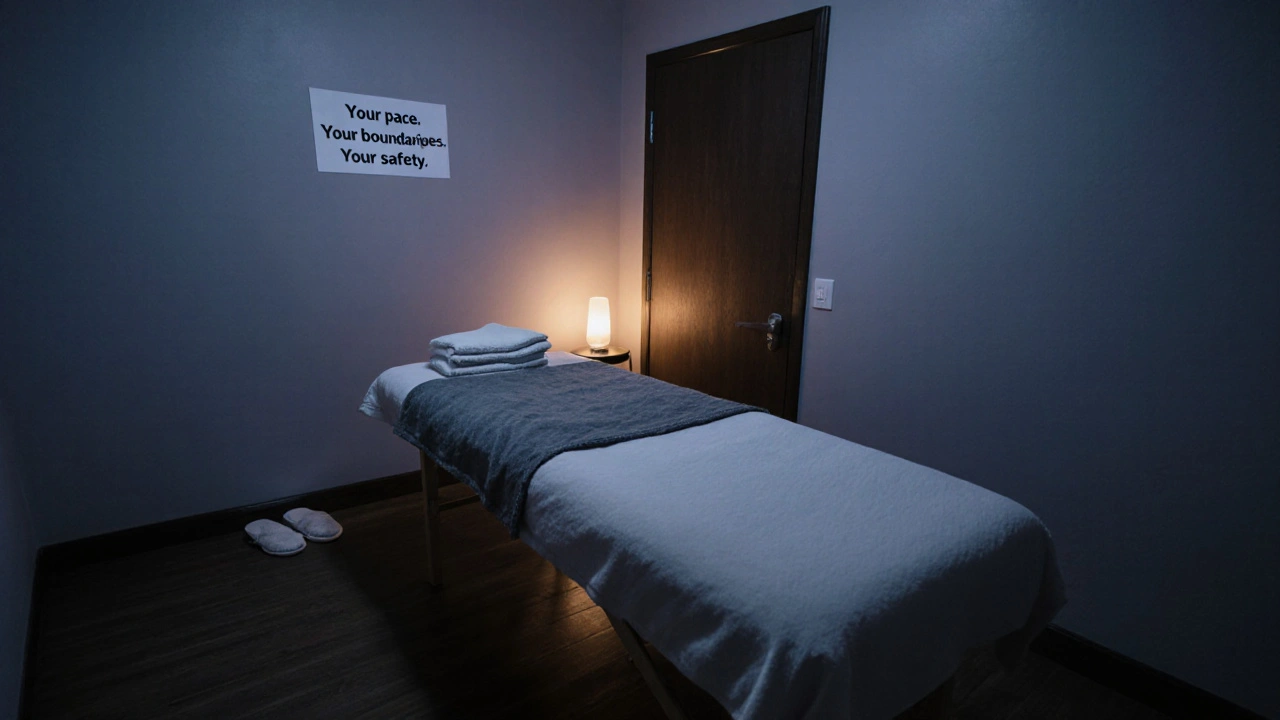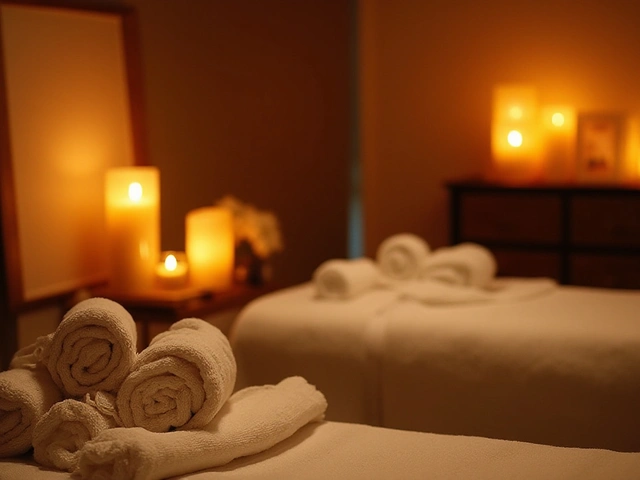For people who feel everything deeply-every touch, every sound, every shift in energy-traditional massage can feel overwhelming, even invasive. The pressure, the pace, the expectation to "just relax" can trigger anxiety instead of calm. But there’s another way. Tantric massage for sensitive individuals isn’t about intensity; it’s about presence. It’s a slow, intentional practice that meets you exactly where you are, without pushing, without agenda, without pressure to perform or release.
What Makes Tantric Massage Different for Sensitive People?
Most massage styles-Swedish, deep tissue, Thai-are built around muscle release and physical relaxation. Tantric massage, especially when adapted for sensitive individuals, is different. It doesn’t aim to fix anything. It doesn’t chase relaxation as a goal. Instead, it invites you to simply be. The touch is soft, warm, and deliberate. It’s not about working knots; it’s about awakening awareness. According to practitioners at Tantra Institute Prague, this form of massage uses three core layers: gentle stroking (called "Tantric Caress"), warm oil application at 38-40°C, and the use of natural textures like soft fur or ostrich feathers. These aren’t decorative choices-they’re tools. For someone whose skin feels like it’s always on high alert, these materials create a safe, non-threatening sensory experience. The oil isn’t just for glide-it’s a bridge between skin and soul, warmed to match body temperature so it doesn’t startle. The biggest difference? Breath. Unlike other massages where the practitioner leads, here the client’s breath is the guide. A certified tantric therapist will pause, wait, and follow your rhythm. If you hold your breath, they slow down. If you sigh, they deepen the touch. According to psychologist Mgr. Lenka Vlčková, conscious breathing accounts for 65% of the therapeutic success with sensitive clients. It’s not magic-it’s neuroscience. When your breath slows, your nervous system shifts from fight-or-flight to rest-and-digest. That’s when real release happens.The Three Levels of Touch-And Which One Is Right for You
Not all tantric massages are the same. For sensitive individuals, there’s a clear progression, and starting too fast can undo the work.- Tantric Caress (60 minutes, ~1900 CZK): This is the entry point. No intimate areas are touched. The entire body is stroked with feather-light pressure, using only the palms and fingertips. This level is designed to rebuild trust in touch. Most clients with sensory sensitivity start here-and many never move beyond it.
- Adoration of Aphrodite (90 minutes, ~2900 CZK): Adds subtle energetic work around the pelvis, but still avoids direct genital contact. This is for those who feel safe enough to explore subtle energy shifts without physical intimacy.
- Healing Joni (120 minutes, ~3500 CZK): Includes internal mapping (vaginal or prostate). This is only for clients who have spent months building trust and have clear boundaries. It’s not a goal-it’s an option.
What You Need Before Your First Session
You don’t need to know anything about tantra. You don’t need to be spiritual. You don’t need to have "healed" your trauma. All you need is openness-and the courage to say no. The most important step? The pre-session consultation. At reputable centers like Tantra Institute Prague or Učerná Venuše, this lasts 20-30 minutes. No rush. No scripts. You talk about:- What touch feels triggering
- What feels comforting
- Any past experiences with touch that left you feeling unsafe
- Your goals (even if it’s just "I want to feel calm")

What to Look for in a Practitioner
Not every massage therapist trained in tantra knows how to work with sensitivity. In fact, a 2023 internal analysis by Relax Club Namaste showed that only 41% of unaccredited practitioners could adjust their touch properly for sensitive clients. The difference? Certification. Look for therapists trained in a 5-day intensive program (M1+M2+M3) covering:- M1: Foundations of tantric touch
- M2: Advanced techniques for energy flow
- M3: Energetic boundaries and emotional safety
What Happens During the Session
There’s no nudity requirement. You can keep your underwear on. You can wear a robe. You can ask for a blanket. The room is dim, quiet, and warm. The therapist will start with your feet, your back, your arms-areas far from the most vulnerable parts. They’ll check in every 5-7 minutes: "How’s the pressure?" "Does this feel okay?" "Want to slow down?" There’s no music with lyrics. No candles that drip. No incense that overwhelms. Just silence, warmth, and the rhythm of your breath. The session ends with 10-15 minutes of stillness. No talking. No rushing. Just lying there, feeling the afterglow of being fully held. That’s when the real healing begins-not during the massage, but after, when your body finally believes it’s safe to let go.
Real Results-And the Risks
A 2022 clinical study by Dr. Petr Novák at the First Faculty of Medicine, Charles University, followed 120 sensitive individuals over six months. Those who received regular tantric massage showed a 68% improvement in emotional regulation. They slept better. They reacted less sharply to stress. They felt more connected to their bodies. But there’s a catch. For 22% of participants, things got worse-not because the massage was bad, but because they were pushed too fast. One client, a trauma survivor, was introduced to pelvic work after just two sessions. The result? She stopped coming back for a year. That’s why expert sex therapist Prof. MUDr. Jiří Dvořák warns: "Some centers blur the line between therapy and sex work. They sell tantra as a quick fix. That’s dangerous for sensitive people. It retraumatizes." Trust your gut. If a therapist rushes you, pushes boundaries, or makes you feel like you owe them something-leave. No refund, no apology, no second chance. Your safety is non-negotiable.The Future of Gentle Touch
This isn’t a trend. It’s a shift. In 2018, there were 12 centers in the Czech Republic offering specialized tantric massage for sensitive clients. By 2023, that number jumped to 47. Revenue in this niche hit 85 million CZK last year and is projected to grow to 112 million by the end of 2023. The biggest driver? Awareness. More people are recognizing that sensitivity isn’t weakness-it’s a neurological trait, like being left-handed or having high empathy. By 2024, Učerná Venuše plans to install biometric sensors in all their rooms to track heart rate and skin conductivity in real time. This lets therapists adjust touch based on your body’s signals, not just your words. Professor Markéta Svobodová from Palacký University predicts that within five years, these therapies will be covered by health insurance for people diagnosed with PTSD, autism, or chronic sensory overload. That’s not fantasy-it’s the next step in integrative medicine.Your Next Step
If you’ve ever flinched at a hug, avoided physical contact, or felt drained after a massage-you’re not broken. You’re sensitive. And there’s a way to reclaim touch without losing yourself. Start here:- Find a center that offers a pre-session consultation. If they don’t, walk away.
- Ask if their therapists are certified in M1+M2+M3 or the new "Gentle Touch" program.
- Book the "Tantric Caress"-60 minutes, no intimate touch.
- Bring a list of what feels safe and what doesn’t. Read it aloud if you need to.
- Afterward, sit quietly for 10 minutes. Don’t rush to text, scroll, or talk. Let your body settle.






